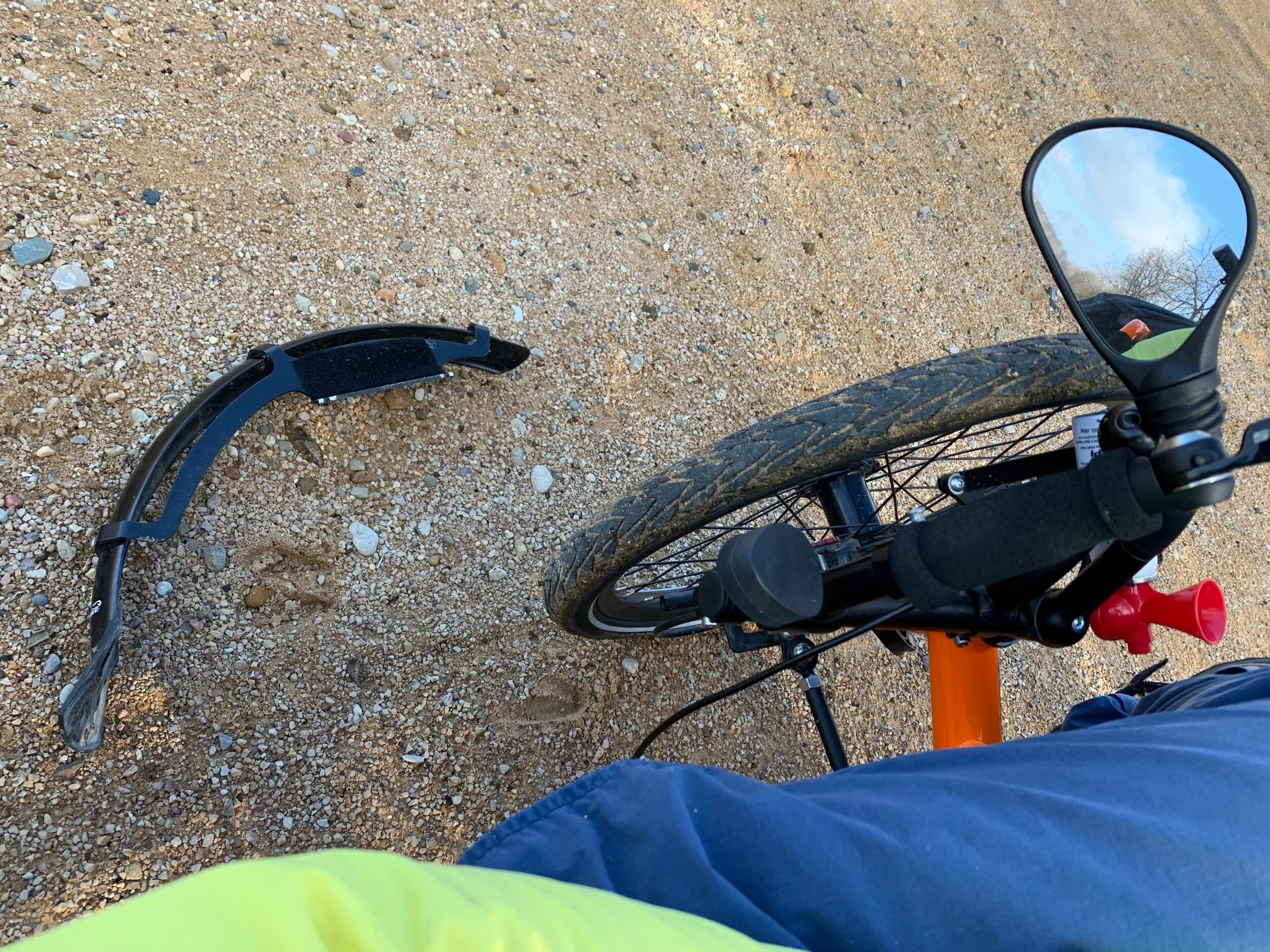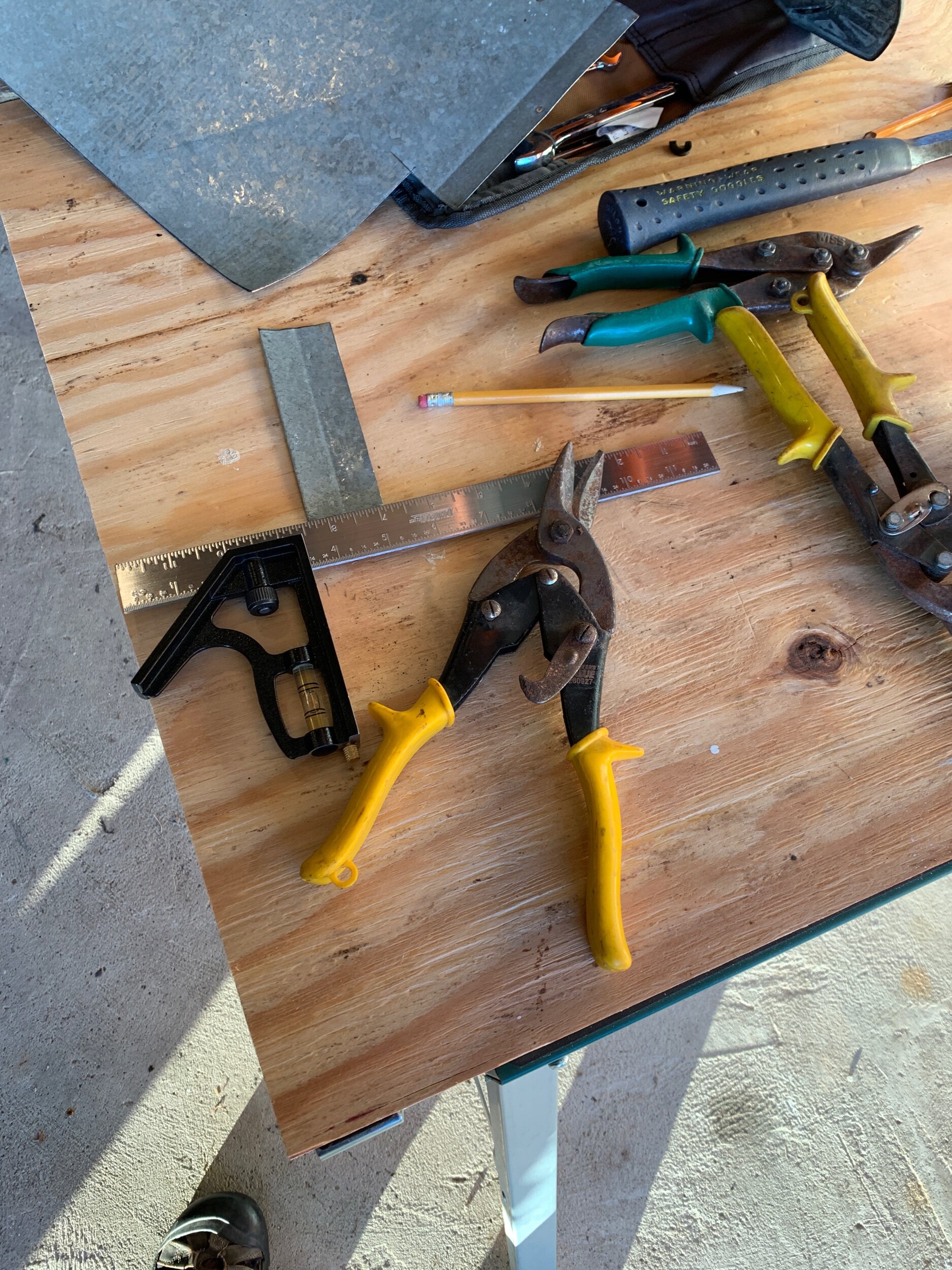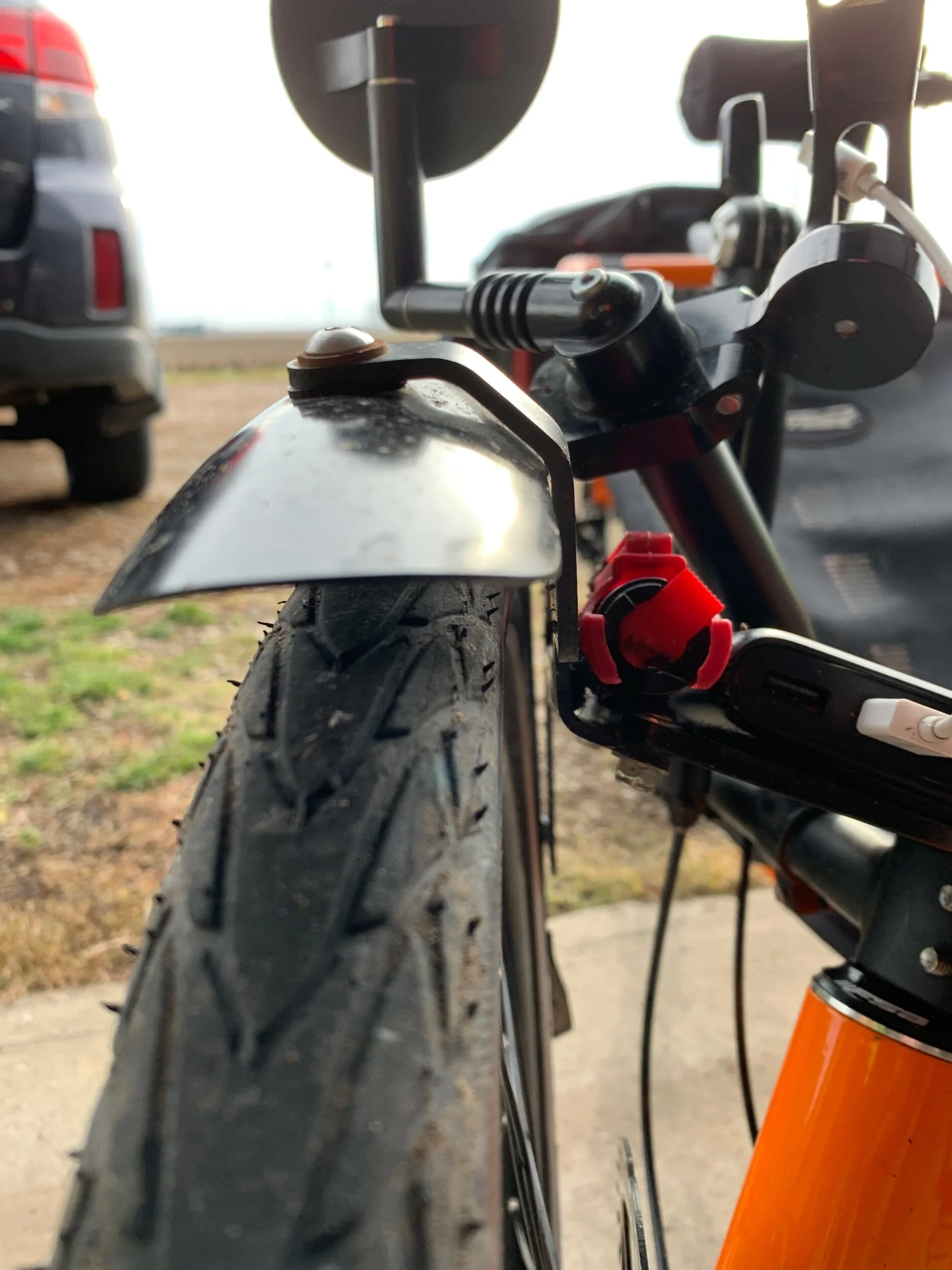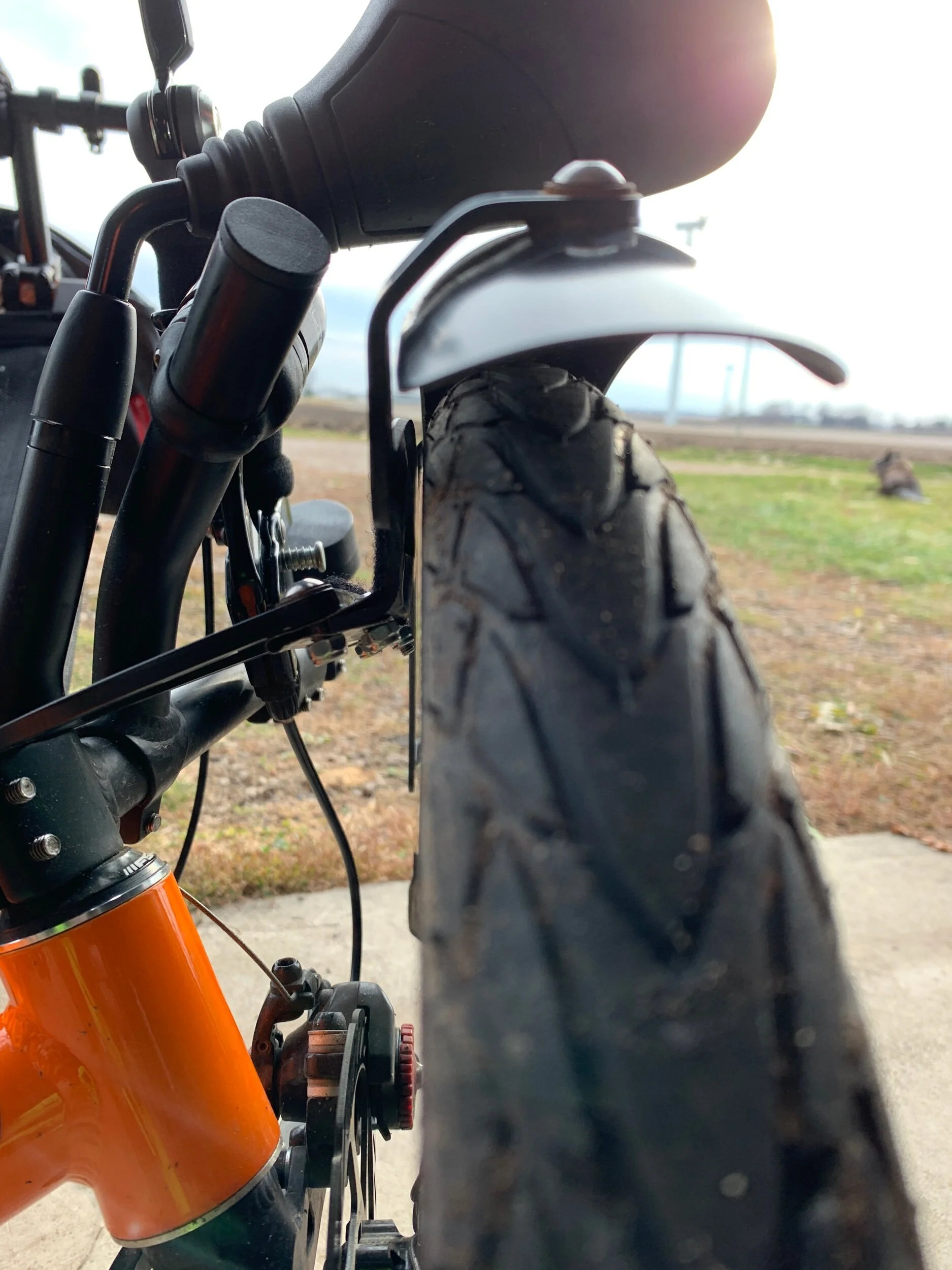I was able to get out to the Hennepin Canal trail for my Black Friday ride, but as I noted last week, the Canal Trail did take a toll on my trike:
In all fairness, this is almost certainly not due to the Canal Trail. In retrospect I realized that I’ve had multiple occasions where the fender on that side seemed to be a little crooked, and I’ve been manually adjusting it when I saw that - e.g. just grabbing it and turning it a bit. I suspect I may have caused some accelerated metal fatigue on the screw tabs by doing this, hastening their demise. In future I will get out my Allen wrenches and adjust it properly (or at least that’s what I’m telling myself right now - future Erin is not always reliable).
My first approach to addressing this problem was to see if I could just buy replacement fenders. And of course I can - but once I saw the cost, after I stopped hyperventilating I thought “hey, I’m a pretty handy guy - maybe I can just fix this myself”.
Now, this is a lie. It’s a lie I’m telling to you, and its a lie I’m telling myself - I am not a handy guy. When I was in high school I worked summers and breaks for my Dad in his plumbing, heating, and cooling business. As I began to move towards the end of my high school career I remember musing aloud to my father that maybe I was considering working in the trades.
I give him full credit for taking at least a brief pause before he said: “Son, you should go to college”.
I’m sure that brief pause was taken up entirely by visions of my actual handiwork. And he was right. The trades are a vital and honorable way to make a living, but one should have some actual aptitude for them before making that choice.
Still, my cheapness gene rises to full height (no aptitude for handiwork, but damn, can I mix a metaphor) when faced with a financial challenge, and tends to override all other factors. I decided I should at least give fixing it a shot before I committed to an expensive order. Then at least I’d feel like I’d done my due diligence.
The fender broke where the screw tabs connect - both of the rings snapped off:
This meant that I needed a way to connect the fender to the fender bracket - essentially that I had to find a way to replace the screw tabs. And I needed it to be done using mataerials I had on hand, and in a fashion that was within my skill set. This last part presents as a primary limitation, and it absolutely informs the solution I arrived at.
I mentioned that I worked for my Dad doing plumbing, heating, and cooling. I didn’t see any way to apply plumbing skills here - I mean, I know waste needs to flow downhill, but that didn’t seem very helpful in this case. But heating and cooling involves ductwork. This may not seem immediately applicable - there’s no need to do anything with forced air here. But if you know a little bit about ductwork (and that’s me - I know a little bit), you can make other things with it. My Dad and his crew used to build their own tool boxes out of the sheet metal they had in the shop, complete with a bit of copper pipe at the top formed into a carrying handle. That was well beyond my capabilities, but this seemed like it would be a lot simpler. And, importantly, I have at home the following items:
- Spare sheet metal (galvanized steel)
- Tin snips
- A drill and metal cutting bits
So - it seemed like it was worth a shot. The first thing I needed to do was figure out to form the bracket. The temptation would be to just cut a single flat piece of sheet metal in the right size and screw it down to each side. I did briefly consider that, but sheet metal tends to be rather springy when flat, and I was concerned that I’d be having the fender bounce into the tire. Besides, sheet metal is much stronger when folded, so I figured I would need a piece folded. But I’d need it to fit over the edge of the fender - replacing where the tabs were, so it would have to be an rounded fold (e.g. not creased flat).
What I don’t have at home is a sheet metal brake - this is a device designed to make folds in sheet metal - or even a hand bender. So I measured and cut my piece and I improvised:
Once I had my piece... Well, once I had my second piece - the first one I cut and made turned out to be a little bit too small - I slid it over the fender and held it up to the mounting bracket and eyeballed it to see if it seemed like it would work. Mostly I was looking to see if it would hold the fender over the tire with sufficient clearance over the top and to the side. And it looked like it would.
The next step was to set up to attach it to the fender and the bracket. The mounting points for the bracket were pretty straightforward - it had mounted to the bracket via bolts before, and I was going to do that again. I lined it up on the bracket, eyeballed it to be sure it was straight, and marked the drill points thru the bracket holes with a sharpie.
Then I needed to figure out how to attach my sheet metal adapter to the fender mount itself. There are probably multiples ways to do this - I wondered, while I was thinking about it, if couldn't be attached using epoxy, for example. But the thing is, I don’t have any experience using epoxy, nor did I have any on hand. But I did have a drill and bolts, so that’s what I went with.
Once I got it on, it actually looked pretty good - it was holding the fender up well. The tolerance was a little tighter than I preferred - it wasn’t quite touching the tire, but I could imagine it doing so on a bounce. I took it off the bracket, but left it on the fender mount, and used a pair of channel locks to bend it slightly along the edge of where it met the fender mount. I used channel locks because I could set them at an opening that kept them from accidentally crushing the open part of the sheet metal adapter. This allowed the adapter to hold the fender up and away from the tire a bit further. The tolerance is still a little tighter than on the other wheel:
But I think it’s open enough. I have had it out for multiple rides since putting the adapter on it, and it doesn’t appear to bounce any more than the other, intact fender, nor does it bounce into the tire. It’s possible that I may run into issues if I find myself riding through mud or snow - which I do from time to time - but I’ll burn that bridge when I come to it.
So I’m counting this as a win. For the low, low price of zero dollars I was able to fashion a repair from found materials and a couple of hours fo work on the weekend. This gets the trike intact and back on the road with a minimum of fuss. And I realize here that I owe an extra bit of thanks to my Dad - he was right about going to college, but he also left me with a subset of skills that still can come in handy (even if I’m not).
There will undoubtedly be a subset of hale and hearty readers out there who will ask “what do you even need fenders for? Just take the other one off too, and go commando!”
To the unfendered out there, let me say that I respect your life decisions. But I am a more delicate soul who experienced a good two years of fending for myself on a Catrike Pocket. I loved riding the Pocket and still do when the occasion presents itself. But the reality is that having twin uncovered wheels spinning right beside you, while no big deal in the dry, throw everything on the road up at you - water, snow, sand, mud, small invertebrates, everything - once the weather becomes damp. I had actually tried to find fenders for the Pocket before getting my Expedition, but came up empty (and while I was successful with my fix here, my skills stop well shy of fabricating an entire fender set - tho I do see that others have done so).
So - you know - you do you...








